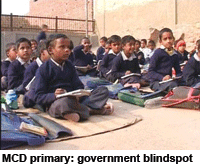That public education is a low priority of the Congress party is hardly a national secret. Although the global average outlay for education is 5 percent of GDP and the Kothari Commission recommended 6 percent way back in 1966, post-independence India’s (Centre plus states) annual allocation for education has never exceeded 4 percent of GDP and averages a mere 3.5 percent. And it’s pertinent to note that Congress governments have ruled in New Delhi and almost all states for over four decades since India became independent in 1947.
 The problem with this illogical and blinkered attitude of the grandiosely titled Congress high command towards public education is that it has spilled over into Congress state governments. On November 20, Delhi chief minister Sheila Dikshit released the 37th issue of Delhi Statistical Handbook 2012 (DSH) — an annual publication of the city state’s directorate of economics and statistics which contains data relating to industrial growth, health, state domestic product estimates, police, crimes, road accidents etc. Although the handbook makes great play about the increase in cellphone users to 42.5 million in 2011-12 from 38.80 million in 2010-11; increase in per capita income to Rs.175,812 in 2011-12 from Rs.150,653 in 2010-11 (the third highest after Goa and Haryana); 98,000 people visiting cinemas daily and similar data which Dikshit interprets as indicators of “a vibrant economy and fast-improving infrastructure in Delhi,” it had little to say about education.
The problem with this illogical and blinkered attitude of the grandiosely titled Congress high command towards public education is that it has spilled over into Congress state governments. On November 20, Delhi chief minister Sheila Dikshit released the 37th issue of Delhi Statistical Handbook 2012 (DSH) — an annual publication of the city state’s directorate of economics and statistics which contains data relating to industrial growth, health, state domestic product estimates, police, crimes, road accidents etc. Although the handbook makes great play about the increase in cellphone users to 42.5 million in 2011-12 from 38.80 million in 2010-11; increase in per capita income to Rs.175,812 in 2011-12 from Rs.150,653 in 2010-11 (the third highest after Goa and Haryana); 98,000 people visiting cinemas daily and similar data which Dikshit interprets as indicators of “a vibrant economy and fast-improving infrastructure in Delhi,” it had little to say about education.
That’s because according to DSH 2012, literacy growth in the state in 2010-11 was at its slowest in the past four decades. While the city state recorded a 4.67 percentage point increase in literacy in 2011 (86.34 percent) from 2001 (81.67 percent), this increase is the lowest decadal growth — even lower than the 4.93 percentage points recorded in 1971-81.
In terms of additional infrastructure created, except for five additions to the aggregate number of middle schools (class VI-VIII) to 583, the number of schools has remained static. On the contrary, in 2008-09, the city state hosted 659 middle schools. Moreover, while the number of anganwadis is static at 50, primary schools have declined for the second consecutive year to 2,563 in 2010-11 from 2,593 in 2008-09. All these are clear indicators that the state and municipal governments have had to close down schools as even low-income households are increasingly opting to enroll children in private budget schools offering better English learning or English-medium education.
This, of course, is not the first-of-its-kind report that questions the government’s education policy and practice. According to a recently released survey conducted by CRY (Child Relief and You), the well-known NGO, basic facilities such as clean drinking water, qualified teachers, conducive classrooms, clean toilets etc, are conspicuously lacking in state and MCD (Municipal Corporation of Delhi) schools. In December last year, 58 MCD schools were declared unfit to function and had to be closed down. Inevitably, the teacher-pupil ratio is adverse with some schools averaging 75 students per teacher, even as special educators required to meet the needs of 2,100 challenged children, are still to be recruited.
Quite obviously, the not ungenerous education budgets of the Delhi state government (Rs.1,247 crore) and MCD (Rs.1,107 crore) for 2011-12 are suffering serious leakages and misutilisation.
“Over the years, private schools have developed successful elementary education models and we would be more than pleased to help if the government works with us to promote public-private partnerships or even sets up advisory committees to help improve government schools and make them competitive. But I doubt there’s any political willingness to do so,” says S.K. Bhattacharya, president, Action Committee for Unaided Recognised Private Schools of Delhi (estb. 2001).
Clearly a change of priorities and mindset of the Congress high command is the precondition of a brighter future for the national capital’s state government and MCD school children.
Swati Roy (Delhi)


























